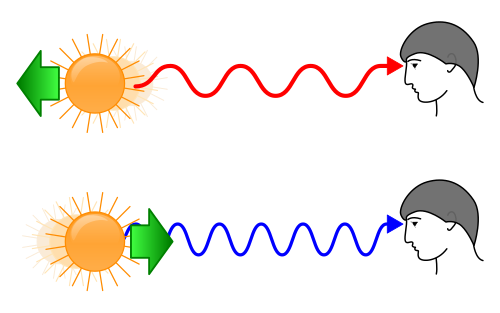Curious about how astronomers measure the speed of stars, discover new planets, and even prove the universe is expanding—all from millions of light-years away?
Welcome to FreeAstroScience.com, where we turn mind-bending science into everyday understanding!
Stick with us as we unravel the Doppler Effect in astronomy—one of the most powerful tools in the cosmic detective’s kit. By the end, you’ll see the universe in a whole new light.
The Doppler Effect in Astronomy: How Does It Help Us Explore the Universe?
What Is the Doppler Effect, and Why Should We Care?
Imagine you’re standing on a street corner. An ambulance races by, siren blaring. As it approaches, the pitch rises. As it speeds away, the pitch drops. That’s the Doppler Effect in action! But did you know this same principle helps astronomers unlock the secrets of the universe?
The Doppler Effect, first described by Christian Doppler in 1842, is the change in frequency or wavelength of a wave as the source moves relative to an observer. It’s not just for sound—light waves do it too! In astronomy, this effect lets us measure how fast stars and galaxies move, spot new planets, and even prove the universe is expanding.
How Do Astronomers Use the Doppler Effect to Measure the Universe?
How Does Light Change When Stars Move?
When a star or galaxy moves toward us, its light waves get squished—making them bluer. If it moves away, the waves stretch out, turning redder. We call these shifts “blueshift” and “redshift.”
This isn’t just a neat trick. It’s a cosmic speedometer!

Figure 1: When a star moves toward us, its light shifts blue; when it moves away, it shifts red. (Image: Wikimedia Commons)
The Doppler Formula
Astronomers use this simple formula to calculate how fast something is moving:
Δλ = change in wavelength
λ₀ = original wavelength
v = velocity of the object
c = speed of light
If you see a big redshift, that object is zooming away from us. A blueshift? It’s coming closer.
What Are the Real-World Applications of the Doppler Effect in Astronomy?
1. Measuring the Universe’s Expansion
Back in the 1920s, Edwin Hubble noticed that almost all galaxies show a redshift. The farther away they are, the faster they’re moving away. This led to Hubble’s Law—and the mind-blowing idea that the universe is expanding.

Figure 2: Redshift surveys help map the universe’s expansion. (Image: Wikimedia Commons)
2. Discovering Exoplanets: The Radial Velocity Method
Ever wonder how we find planets around distant stars? The Doppler Effect is our secret weapon. As a planet orbits its star, it tugs the star back and forth. This wobble causes tiny shifts in the star’s light—red, then blue, then red again. By tracking these shifts, astronomers can spot planets, estimate their mass, and even guess at their orbits.

Figure 3: The radial velocity (Doppler) method is a leading way to find exoplanets. (Image: Wikimedia Commons)
3. Studying Binary Stars and Galactic Rotation
Binary stars—two stars orbiting each other—show regular red and blue shifts as they dance around. By measuring these, we can figure out their masses and orbits.
Galaxies, too, reveal their secrets. By mapping redshift and blueshift across a galaxy, we can see how fast it spins and even estimate its mass.
What Are Redshift and Blueshift? Why Do They Matter?
Redshift and blueshift aren’t just technical jargon. They’re the fingerprints of motion in the cosmos.
- Redshift: Light stretches as objects move away. It’s a sign the universe is getting bigger.
- Blueshift: Light compresses as objects come closer. It’s rare on a cosmic scale, but we see it in some nearby galaxies and stars.
Key Takeaway:
Every time we measure a redshift or blueshift, we’re reading the universe’s diary—learning about its past, present, and future.
How Has the Doppler Effect Led to Recent Discoveries?
- Hot Jupiters: The first exoplanets found were giant, close-in planets. Their strong gravitational pull made their stars wobble a lot—easy to spot with Doppler shifts.
- Earth-like Planets: Missions like Kepler use Doppler data to find smaller, rocky worlds that might be like ours.
- Atmospheric Studies: By analyzing how starlight changes as it passes through a planet’s atmosphere, we can even detect winds and weather on distant worlds.
Why Is the Doppler Effect So Important for Astronomy?
Without the Doppler Effect, we’d be nearly blind to the universe’s motion. It’s how we:
- Prove the universe is expanding
- Find new worlds
- Measure the speed of stars and galaxies
- Study the weather on planets light-years away
And the best part? We do all this from right here on Earth, just by reading the light that reaches our telescopes.
Conclusion: What Does the Doppler Effect Teach Us About Our Place in the Universe?
The Doppler Effect is more than a scientific curiosity. It’s a cosmic translator, turning tiny shifts in light into stories about the birth, life, and fate of the universe.
By understanding these shifts, we don’t just learn about distant stars—we learn about ourselves, our origins, and our future.
So next time you hear a siren change pitch, remember: you’re hearing the same effect that lets us measure the heartbeat of the cosmos.
At FreeAstroScience.com, we believe science should be for everyone. The universe is vast, but with the right tools—and a little curiosity—we can all be explorers.
Keep looking up, keep asking questions, and never stop wondering. The universe has so much more to tell us.


Post a Comment